Imagine a sun-scorched landscape where almost all shade vanishes under the sun’s relentless gaze. You might question if life can thrive here. Yet amid the rocky soil and intense heat, the aloe plant stands proud. Like the ideal spouse, this natural multitasker is both practical and visually striking.
The aloe plant is not just a quick fix for sunburns, as many believe. It belongs to a genus containing over 500 species. This spiky, succulent beauty finds its way into various aspects of our lives. It’s in beauty products, medical treatments, and even food. Moreover, some cultures honor it as a symbol of resilience and renewal.
Despite its prickly look, don’t mistake it for a cactus. The aloe is part of the Asphodelaceae family, not the Cactaceae. Even their taxonomic orders are different. What sets the aloe apart are its fleshy, water-storing leaves, medicinal benefits, and unique reproductive features like tubular flowers. In a world keen on generalizations, the aloe’s multifaceted nature invites a closer look.
So why is this plant a linchpin in wellness, tradition, and spirituality? How can you not only value its diverse uses but also grow it at home? This guide dives into the captivating world of common aloe plants. We’ll explore their varied uses and share care tips. Soon, you’ll see why this plant deserves a spot not just in your garden, but in your life as well.
20 of the Most Common Aloe Plants the Human Species is Blessed to Know
| Number | Plant Name | Origin & Appearance | Common Uses |
|---|---|---|---|
| 1 | Aloe Vera (Aloe barbadensis miller) | Native to Arabian Peninsula; Green, fleshy leaves | Medicinal, Skincare, Culinary |
| 2 | Aloe arborescens | Native to Southern Africa; Blue-green leaves with red margins | Medicinal, Ornamental |
| 3 | Aloe ferox | Native to South Africa; Thick, spiky leaves | Medicinal, Cosmetic, Ornamental |
| 4 | Aloe perryi | Native to Yemen; Thin, pointed leaves | Medicinal, Skincare |
| 5 | Aloe striata | Native to South Africa; Smooth, grey-green leaves | Ornamental, Medicinal |
| 6 | Aloe aristata | Native to South Africa; Rosettes with white specks | Ornamental, Medicinal |
| 7 | Aloe maculata | Native to Southern Africa; Flat, broad leaves | Ornamental, Medicinal |
| 8 | Aloe brevifolia | Native to South Africa; Short, stubby leaves | Ornamental |
| 9 | Aloe variegata | Native to South Africa; Triangular leaves with white stripes | Ornamental, Medicinal |
| 10 | Aloe jucunda | Native to Somalia; Small, globular rosettes | Ornamental |
| 11 | Aloe marlothii | Native to Southern Africa; Tall, branching structure | Ornamental, Medicinal |
| 12 | Aloe dichotoma (Quiver Tree) | Native to Namibia, South Africa; Tree-like structure | Ornamental, Medicinal, Cultural |
| 13 | Aloe vera ‘Chinensis’ | Cultivated; Smaller, more compact | Medicinal, Skincare |
| 14 | Aloe polyphylla (Spiral Aloe) | Native to Lesotho; Spiraling leaves | Ornamental |
| 15 | Aloe cameronii | Native to Malawi and Zimbabwe; Reddish leaves in sun | Ornamental, Medicinal |
| 16 | Aloe humilis | Native to South Africa; Short, spiky leaves | Ornamental, Medicinal |
| 17 | Aloe ciliaris (Climbing Aloe) | Native to South Africa; Long, thin leaves; climbs | Ornamental, Medicinal |
| 18 | Aloe tenuior | Native to Southern Africa; Thin, wiry stems | Ornamental, Medicinal |
| 19 | Aloe mitriformis | Native to Southern Africa; Short, wide leaves | Ornamental, Medicinal |
| 20 | Aloe cryptopoda (Wickensii) | Native to East Africa; Dark green leaves | Medicinal, Ornamental |
Haven’t I Seen You Somewhere Before? Meet the Most Common Aloe Plants

In the popular imagination, aloe plant often equals aloe vera. And for good reason.
©iStock.com/Nenov
Aloe Vera (Aloe barbadensis miller)
Whether you’re sunburned or grappling with a pesky pimple, you’ve probably reached for an aloe-based product at least once in your life. But did you know that the humble aloe plant boasts a variety of species with a wealth of uses beyond skin relief? According to the National Institutes of Health (NIH), topical application of aloe gel not only improves acne but also speeds up burn healing. While you may know Aloe Vera for its fleshy, lance-shaped leaves and healing gel, there are other intriguing species worth discovering.
Origin & Appearance
Native to the Arabian Peninsula but now found worldwide, Aloe Vera is the quintessential aloe plant. Characterized by its fleshy, lance-shaped leaves filled with translucent gel, it’s a household name in the realm of natural remedies.
Common Uses
In addition to its well-known applications for skin conditions and wound healing, Aloe Vera serves as a base in cosmetics and health supplements. Its topical gel can alleviate a range of skin issues such as acne, burns, and even conditions like psoriasis.
Scientific Insights
According to the NIH, topical application of Aloe Vera’s gel can speed up the healing process of burns and improve acne. When ingested, it may offer potential relief for symptoms of irritable bowel syndrome and ulcerative colitis. However, be cautious. While topical use is generally well-tolerated, oral consumption of aloe latex and leaf extracts has been linked to adverse effects, especially during pregnancy and breastfeeding.

The krantz aloe or candelabra aloe is native to regions of southern Africa.
©iStock.com/Denira777
Aloe Arborescens
Also known as the “krantz aloe,” Aloe Arborescens is native to southern Africa. This species is especially known for its stunning red or orange flower spikes, often contrasting vividly with its dark green leaves. While its gel has similar healing properties to Aloe Vera, this variety is more commonly used for its aesthetic appeal in gardens and landscapes.
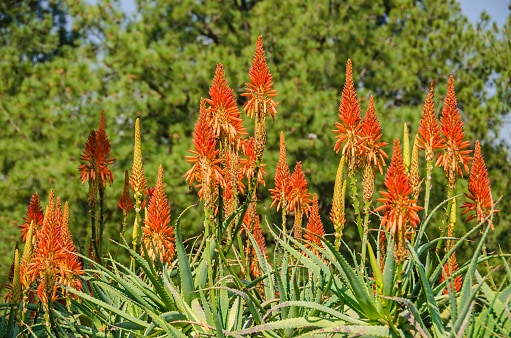
Aloe ferox in Pretoria, South Africa.
©laranik/iStock via Getty Images
Aloe Ferox
Hailing from South Africa’s Cape Province, Aloe Ferox, also known as the “Cape Aloe,” is a powerful plant. Its thick, spiky leaves contain a powerful latex used for its potent laxative properties. But be warned: the latex should only be used under medical supervision.

Fan aloe is particularly good for accentuating landscapes, since they are both hardy and striking when they flower.
©onlyjayne/Shutterstock.com
Aloe Plicatilis (Fan Aloe)
This unique aloe, native to the mountainous regions of South Africa, is recognizable by its fan-like arrangement of leaves, making it a popular ornamental plant. The Fan Aloe is a particularly hardy plant, adept at surviving in rocky, nutrient-poor soils.
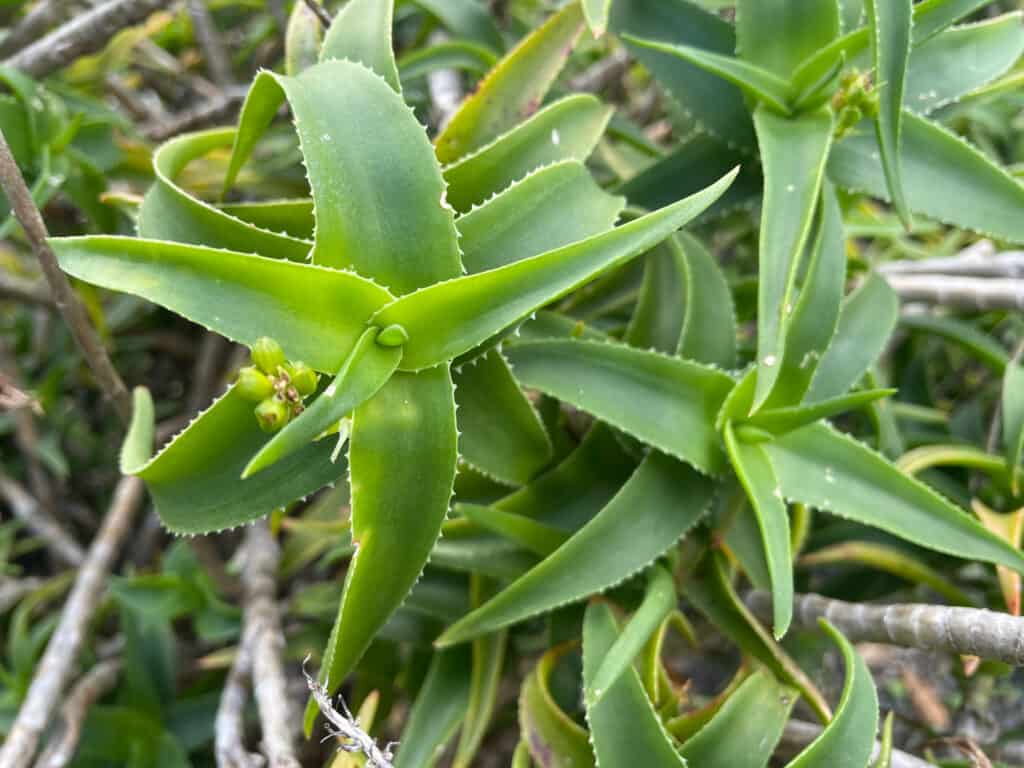
When supported, climbing aloe can rise above 16 feet.
©Ladykhris/Shutterstock.com
Aloe Ciliaris (Climbing Aloe)
The fast-growing Aloe Ciliaris from South Africa has the remarkable ability to climb up to 5 meters (16.40 feet) if supported. It’s perfect for any vertical garden. Also, it serves as a valuable nectar source for birds and insects.
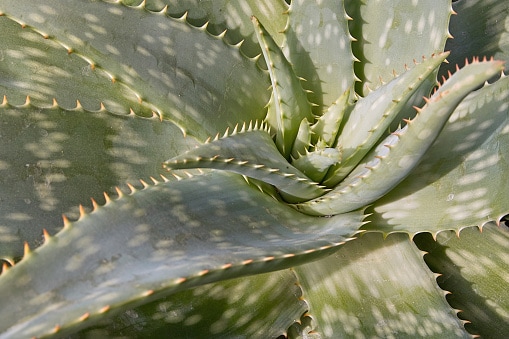
Soap aloe is hygiene and healing workhorse.
©ffaber53/iStock via Getty Images
Aloe Maculata
Commonly called the “Soap Aloe” due to the soapy texture of its leaf sap, Aloe Maculata is another South African native. It’s a compact plant with spotted leaves and an array of uses that range from wound healing to natural cleaning agents.
The Many Uses of Aloe Plants
Aloe plants’ functional attractiveness extends far beyond their visual appeal. These succulent plants offer a variety of uses, ranging from health and wellbeing to home applications. Let’s look at the numerous applications that make aloe plants important in modern life.
Aloe Plants and Health and Wellness
Aloe Vera
The gel is the star here, widely used for skin conditions like burns, sunburn, and minor abrasions. Aloe Vera gel is rich in antioxidants and vitamins, and many swear by its anti-inflammatory properties.
Aloe Ferox
Apart from its well-known laxative effects, the plant is also gaining recognition for its use in wound care and as an immune system booster.

Many organic skincare products use aloe vera.
©Veronika Viskova/iStock via Getty Images
Skincare and Cosmetics
Aloe Vera
Again, Aloe Vera dominates this category. Its hydrating and soothing qualities make it a prime ingredient in lotions, face creams, and even makeup products.
Aloe Arborescens
While not as famous as its Vera kin, the gel of this aloe species is also found in various skincare products and is especially effective for treating dry skin.
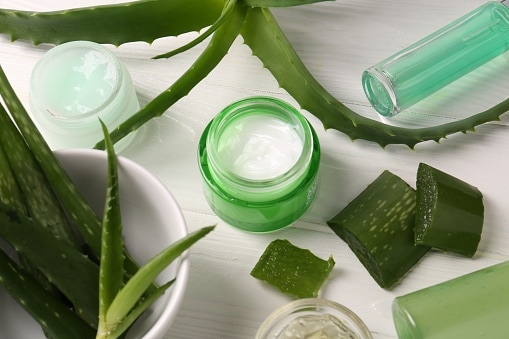
The soothing elements of aloe vera are well-known in medicinal use, but lesser known is their cosmetic use.
©Liudmila Chernetska/iStock via Getty Images
Aloe Plants: Household Uses
Aloe Maculata (Soap Aloe)
The soapy sap can act as a mild cleanser. Historically, people have used it to clean cooking utensils and for personal hygiene.
Aloe Vera
Known for its air-purifying qualities, keeping an Aloe Vera plant indoors can contribute to a healthier home environment.
Gardening and Landscaping
Aloe Plicatilis (Fan Aloe)
This species is an excellent choice for rock gardens, and its unique leaf arrangement makes it the peacock of the bunch.
Aloe Ciliaris (Climbing Aloe)
Perfect for vertical gardens, its climbing nature adds new heights to your outdoor space.
Aloe Plants in Food and Beverages
Aloe Vera
Believe it or not, Aloe Vera gel is edible and often used in beverages and desserts, although it’s crucial to prepare it properly to avoid the bitter taste. It’s especially popular in the Asia Pacific.
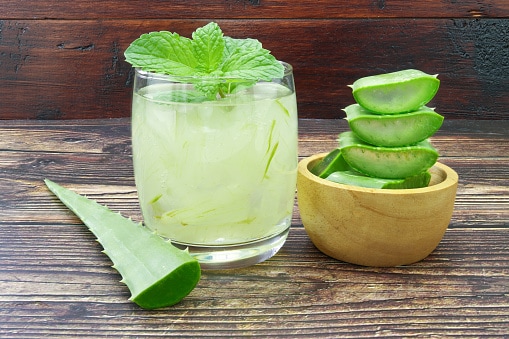
Popular in the Asia Pacific region, drinks featuring aloe vera can be particularly refreshing.
©piyaphun/iStock via Getty Images
Unconventional Uses of Aloe Plants
Aloe Ciliaris
Its rapid growth rate makes it a candidate for soil erosion control in certain climates.
Aloe Ferox
Some communities use the hard, dried leaves as a natural barrier or fence.
Growing and Caring for Your Aloe Plant
Growing aloe plants is a rewarding and not too labor-intensive endeavor. These sun-loving succulents not only purify your indoor air but also provide a host of health and skincare benefits right at your fingertips. Here are some tips to ensure your aloe plants thrive.
Light and Placement
Sunshine is Key
Aloes adore sunlight. Place them in a sunny spot where they can get at least six to eight hours of sunlight a day. A south or west-facing window is ideal for indoor plants.
Outdoor Care
If you’re planting aloes outside, opt for a location that receives ample sunlight but also offers some shade to protect the plants from scorching heat.
Watering Schedule
Less is More
Aloes have a genius for water storage, which means they don’t require frequent watering. Overwatering is a common mistake and can lead to root rot.
Seasonal Adjustments
Water needs change with the seasons. In summer, a bi-weekly watering routine is adequate. Whereas in winter, once a month is good enough.
Soil and Potting
Well-Drained Soil
Choose a well-draining soil mix, preferably cactus or succulent soil. Children of the arid climes, poor drainage can be a death sentence for aloes.
Pot Selection
Pots with drainage holes are a must. The pot should also be spacious enough to accommodate the plant’s root system but not so large that the soil stays wet for prolonged periods.
Fertilizing and Feeding
Minimalist Approach
Aloes are not heavy feeders. A mild, balanced fertilizer every four to six weeks during the growing season (summertime if in a cold or cool climate, year-round if in warmer climates) is enough to keep your plant healthy.
Pests and Problems
Watch Out for Pests
While generally low-maintenance, aloes can fall prey to common pests like aphids and mealybugs. Insecticidal soaps or a simple spray of diluted dish soap will take care of the bug problem.
Brown Tips
If you notice the tips of your aloe turning brown, it could be an indication of too much sun or fluoride in tap water (for plants sensitive to fluoride). This can be remedied by either using rain water or mixing your tap water with rain water or distilled water.
Propagation Tips
Offshoots and Cuttings
The easiest way to propagate aloe plants is by separating the offshoots, also known as “pups,” from the parent plant. You can also propagate aloes from leaf cuttings, although this method is less reliable.

Cleopatra, known for keeping her ear to the ground, made aloe vera key part of her daily beauty routine.
©Mik122/iStock via Getty Images
Interesting Facts About Aloe Plants
1. Ancient Civilizations’ Go-To Remedy
Aloe has a history of medicinal use going back to ancient Egypt, where it was known as the “plant of immortality.” Cleopatra and Nefertiti are said to have used it as part of their beauty routine.
2. Aloe and Space
Believe it or not, Aloe Vera was chosen by NASA for an experiment aboard the Space Shuttle Discovery to study the effects of zero gravity on the plant’s growth and development.
3. Spiky but Soft
While many aloe leaves have a spiky exterior, the inside is filled with a gooey substance that is rich in nutrients, vitamins, and medicinal compounds.
4. Quick Regeneration
Aloe plants are incredibly resilient and can regenerate from just a leaf cutting. They’re like the “Wolverine,” if not the “Deadpool,” of the plant world.
5. Colored Varieties
While we often think of aloe as green, some species, such as Aloe cameronii, can turn a beautiful shade of red or orange when stressed or exposed to sun.
6. Endangered Aloes
Some aloe species like the Aloe polyphylla (the spiral aloe that swirls counterclockwise) are endangered in the wild due to over-collection and habitat fragmentation and destruction.
7. False Advertising
Not all products labeled “Aloe Vera” in the market are pure; some may contain only a small percentage of real aloe, so it’s always best to read labels carefully.
8. Travel-Friendly
The Aloe Vera plant can store water in its leaves, allowing it to survive long periods without water. This feature makes it a convenient travel companion for those who often forget to water their plants.
9. Flowering Aloes
Some aloe species produce beautiful flowers that attract pollinators. The colors can range from red and orange to yellow and even white.
10. Not a Cactus
Despite its appearance and its ability to thrive in arid conditions, aloe is not a cactus but belongs to the lily family.
11. Aloe in Literature
Aloe is mentioned in the Bible, and in the works of Greek scientists like Dioscorides as a medicinal plant.
Conclusion
From the arid deserts of Africa to the windowsills of suburban homes and urban apartments, aloe plants have found a place in diverse landscapes and even more diverse uses. Whether you’re looking for a hardy, low-maintenance houseplant, a first-aid salve, or an ingredient to level up your skin-care routine, aloe plants offer something for everyone.
Understanding the specific types of aloe and their unique benefits allows us to make the most of these wonders of nature. As we’ve seen, aloe isn’t just a one-trick pony—it’s a multitasker that plays roles in healthcare, culinary arts, and even industrial applications.
Whether you’re an experienced gardener or a curious beginner, there’s an aloe plant for you. And who knows? The next great use for this amazing plant could be just a thought or experiment or thought-experiment away. Happy growing!
The photo featured at the top of this post is © iStock.com/cgdeaw
Thank you for reading! Have some feedback for us? Contact the AZ Animals editorial team.







